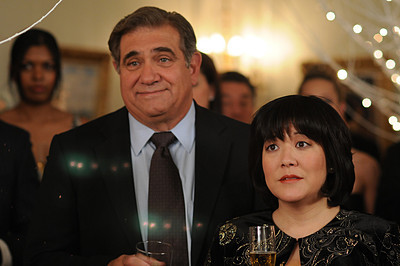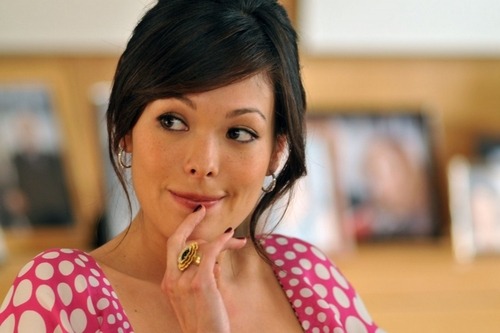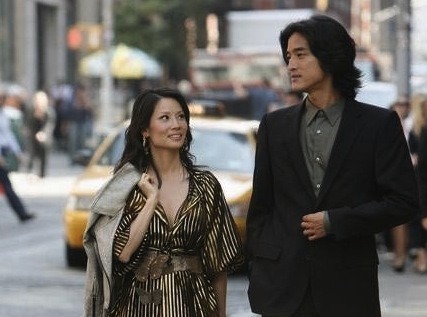In the Season 2 finale (which turned out to also be the series finale) of Lipstick Jungle, we meet Victory Ford’s parents.

Now, actress Lindsay Price is half Korean, half “white bread American,” but no mention is made of Victory’s ethnic heritage until this last episode. The only slight reference we get is when she and Wendy move a folding partition from Victory’s store into Wendy’s apartment to create a home-office space. The wall divider has Korean characters on it, and Victory jokes about what they mean.
Note: We could assume that Victory’s somewhat conservative stance on nudity and alcohol draws from an Asian-influenced upbringing… But I don’t think that was really the writers’ intention. I think they chalked that up to her being from the traditional-values-loving Midwest.

Anyway, as a fellow halfie, part of me liked that Victory’s background was never an issue, and part of me was disappointed.
On the one hand, it’s no fun when ethnicity becomes a character’s defining trait. It’s too easy to get caught up in race politics that way, not to mention stereotypes and bad jokes. So I’m glad that Victory just was whoever she was — “incidentally Asian” — without it coming up all the time.
On the other hand, ethnicity and culture do play a part in one’s identity. Whether you embrace it, deny it, or something in between, it’s a factor. So for it to never come up seems a bit odd. Would it have been so hard to show a Korean influence in Victory’s home decor? Or in her fashion designs? Would that not have made her more distinct as a character, without it becoming a Thing that needed to be mentioned aloud?
Sidebar: Actually, that balance is something I think the writers of Cashmere Mafia handled well with Lucy Liu and her character Mia Mason. Mia’s Asian-ness is never directly mentioned by her friends or coworkers, but at some point we meet her parents, and we get a few cultural insights (from all sides) when they try to set her up with a handsome Chinese neurosurgeon.

Look, it’s not like I run around shouting “I’m half Asian!” Many people would probably never even know. But my heritage does subtly color my thoughts, my values, and my actions. It would be nice to see that accurately depicted more often.
To be clear: I’m not saying Lipstick Jungle did a bad job. Far from it. I just think they could have done better. (And who knows, maybe that’s an angle they were planning to explore if the show continued.)
7 responses to “A note about the finale of Lipstick Jungle and being “incidentally Asian””
Note: While you were growing up, Dad frequently commented how much you and I looked alike. No offense, I never saw it. I think it is interesting when you say “Many people would probably never even know.” I think you clearly show features from both of your primary races. (We’re quite mutts on Dad’s side. Sorry, that wasn’t meant to be offensive. Just my point of view.)
People have said that to me as well. :) While I’m not certain I would say that we “look alike,” I do think there is a family resemblance. As I’ve gotten older, I’ve noticed that my facial structure is more similar to Dad’s, in particular. But I agree that I show features from both parents, which makes me happy.
That said, people who aren’t familiar with Asian looks often don’t realize that I’m mixed, because they don’t have the context to make that connection. It’s not a big deal, just something that I have observed over the years.
Actually, I’ve gotten asked on more than one occasion if I’m part Mexican, hehe.
Huh, have you posted this elsewhere before? It looks familiar. But yeah, portraying Asianness in media can be complicated. I’m working on a post about that in YA fantasies. Hoping to get it posted sometime this week or next week!
LOL yes, this is one of the posts that I brought over from my Tumblr. I still have a couple left.
In A Sane Woman (my first novel) there are three characters (two brothers and a sister) who are central chracters, and I don’t specify right away that they are Black. I’m sure some readers assume they are white (many people assume characters are white and straight unless told otherwise immediately). I don’t refer to their race a lot, but I do bring in how religious their parents were and how church-oriented their upbringing was (and they all have biblical names — because that’s what their parents would have chosen for them). The parents are dead, and I mention that the older brother and sister (who live together) have a lot of old, large furniture in their apartment, and my idea was that they ended up with a lot of their parents’ furniture, though I don’t bring that up in the book. It’s not a foreground thing, but it fits together (I hope) if anybody starts to think about it.
Yeah, I’m not sure how to address the issue of “default = white.” Like, we need to be able to visualize characters quickly, but we definitely don’t want to give a list of traits like skin color, race, etc.
Like you, Anthony, I wrote characters without referring to their race in TWENTY-SOMEWHERE. Partly I wanted to let readers imagine them however, and partly I WANTED to challenge people’s expectations by not spelling things out right away.* Around the halfway point (out of 40 episodes) I mentioned that a certain character was Chinese, using both her last name and discussion of the Lunar New Year holiday. I’ve only read one or two reviews that mentioned it, and one of those was quite upset, almost as if they felt deceived. Shrug. I suppose that’s fair, because I was withholding the information. But I hope that reviewer questions why she assumed all three characters were white in the first place.
(Note: The whole project was experimental from the start, so I’m not saying I would do this with every story.)
I tend to not do a lot of character description anyway — that’s just the way I write. I focus more on dialogue and action, with enough description to set the scene (I hope :-) ). So, it’s not like I’m giving an extensive character description but just omitting race. And I don’t do this all the time — once per book at most — or otherwise it becomes a gimmick. (I may have linked to this post already, but it talks about where I got the idea to do this: http://u-town.com/collins/?p=27.)
I withhold a new character’s sexuality more often, because that’s how it is when you meet new people.
And, yes, different stories and characters sometimes have to be treated differently. My detective character (Jan Sleet) dresses very unusually (and she’s rather odd looking in general), so I always describe what she’s wearing, because her unusual appearance explains a lot about how people react to her.